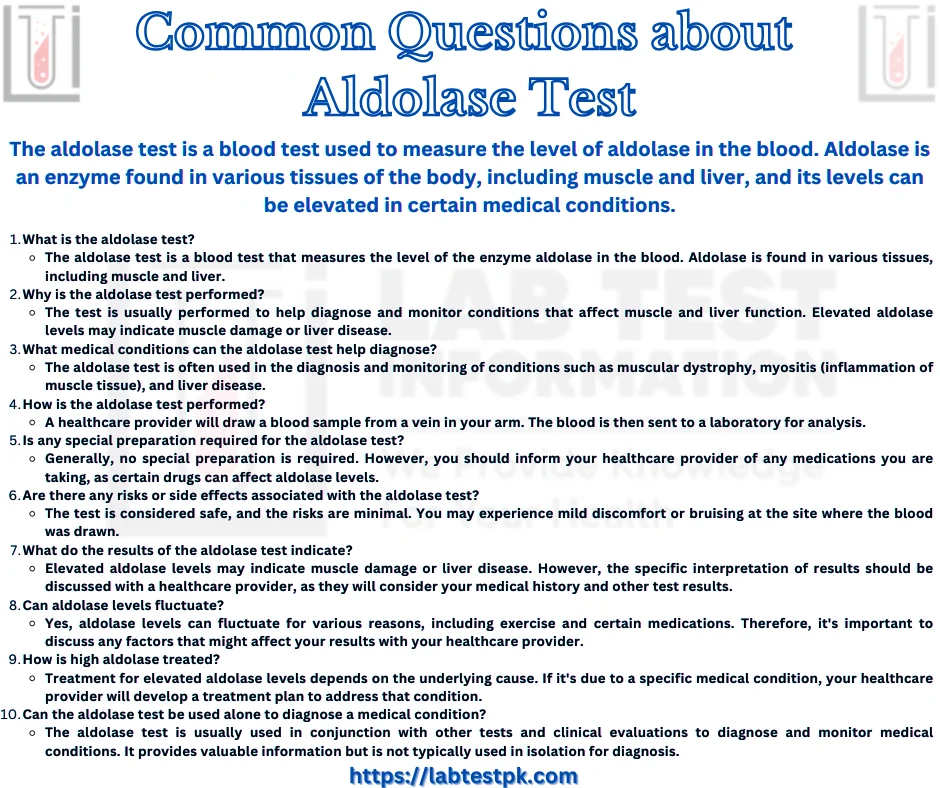Aldolase Function
Aldolase Function, Aldolase is an enzyme that plays a crucial role in glycolysis, a metabolic pathway that breaks down glucose into pyruvate. This enzyme specifically catalyzes the reversible conversion of fructose-1,6-bisphosphate into two three-carbon sugar molecules, dihydroxyacetone phosphate (DHAP) and glyceraldehyde-3-phosphate (G3P). This reaction is called the aldol cleavage or aldolase reaction.
Glycolysis is an essential process in energy metabolism, as it generates ATP (adenosine triphosphate), the primary energy currency of cells, and pyruvate, which can further be metabolized in various ways depending on the cell’s energy needs and oxygen availability. The aldolase enzyme helps regulate the flow of glucose through the glycolytic pathway.
Types:
There are several types of aldolase enzymes, each catalyzing the aldol reaction in different substrates or under specific conditions. Some of the most well-known types of aldolases include:
- Aldolase A (ALDOA): This enzyme primarily catalyzes the cleavage and formation of carbon-carbon bonds in glycolysis, which is the metabolic pathway that breaks down glucose into pyruvate. Aldolase A is found in most tissues, especially in muscle tissue, and plays a crucial role in energy production.
- Aldolase B (ALDOB): Aldolase B is primarily found in the liver and kidney and is involved in the fructose metabolism pathway. It catalyzes the conversion of fructose-1-phosphate into dihydroxyacetone phosphate and glyceraldehyde.
- Aldolase C (ALDOC): This enzyme is found predominantly in the brain and is involved in glycolysis in neural tissues. It catalyzes the same reactions as aldolase A but is expressed in a tissue-specific manner.
- Class II Aldolases: These enzymes are involved in various metabolic pathways and may not be as well-characterized as the three classic aldolase enzymes mentioned above. They catalyze aldol reactions in different substrates and contexts.
- Dihydroxyacetone phosphate (DHAP) aldolase: This enzyme catalyzes the reversible conversion of DHAP to glyceraldehyde-3-phosphate, an essential step in glycolysis.
- Fructose-1,6-bisphosphate aldolase: This enzyme is involved in the glycolytic pathway and catalyzes the reversible cleavage of fructose-1,6-bisphosphate into dihydroxyacetone phosphate (DHAP) and glyceraldehyde-3-phosphate.
- Triosephosphate isomerase (TPI): While not a traditional aldolase, TPI is an enzyme involved in glycolysis that interconverts dihydroxyacetone phosphate (DHAP) and glyceraldehyde-3-phosphate (G3P). It plays a crucial role in glycolytic energy production.
These are some of the key types of aldolase enzymes with various roles in different metabolic pathways. They are essential for the proper functioning of cellular metabolism, energy production, and the maintenance of homeostasis within cells and tissues.
Conditions or Diseases Requiring the Aldolase Test:
Elevated levels of aldolase can indicate damage or disease in these tissues. Conditions or diseases that may require the aldolase test include:
- Muscular Dystrophy: Various forms of muscular dystrophy can cause muscle damage and result in increased aldolase levels in the blood.
- Myositis: Myositis is a group of inflammatory muscle diseases that can lead to muscle weakness and damage, causing elevated aldolase levels.
- Muscle Injury: Any significant muscle injury, such as a crush injury or severe muscle strain, can lead to elevated aldolase levels.
- Liver Disease: In some cases of liver disease, such as hepatitis or cirrhosis, aldolase levels may be elevated. However, it is not typically used as a primary marker for liver disease.
- Autoimmune Diseases: Certain autoimmune diseases like systemic lupus erythematosus (SLE) and rheumatoid arthritis can cause muscle inflammation and may result in increased aldolase levels.
- Dermatomyositis: Dermatomyositis is a specific type of myositis that primarily affects the skin and muscles, often leading to elevated aldolase levels.
- Polymyositis: Polymyositis is another form of myositis characterized by muscle inflammation and damage, which can cause elevated aldolase levels.
- Neurological Conditions: Some neurological disorders, like motor neuron disease, may lead to muscle damage and increased aldolase levels.
- Carbon Monoxide Poisoning: Carbon monoxide poisoning can cause tissue damage, including muscle damage, which may result in elevated aldolase levels.
What Does the Aldolase Test Result Mean:
The interpretation of aldolase test results can vary depending on the context and the specific condition being investigated. Here are some general interpretations:
- Normal Range: A normal aldolase level typically indicates that there is no significant muscle damage or disease. Normal reference ranges may vary from one laboratory to another, so it’s essential to consider the specific reference range provided with your test results.
- Elevated Aldolase: An elevated aldolase level can suggest muscle damage or disease. Some conditions and situations that can lead to elevated aldolase levels include:
- Muscle Injury: Aldolase levels can rise after muscle injuries, such as strains, sprains, or trauma.
- Muscular Dystrophy: Certain types of muscular dystrophy can cause increased aldolase levels.
- Myositis: Inflammatory muscle diseases like polymyositis and dermatomyositis often lead to elevated aldolase levels.
- Liver Disease: In some cases, elevated aldolase levels can be associated with liver disease.
- Heart Attack: While not a primary indicator of a heart attack, aldolase levels can sometimes be elevated in the context of heart muscle damage.
- Serial Monitoring: In some cases, doctors may order aldolase tests periodically to monitor changes in aldolase levels over time. This can help track the progression of muscle diseases or the effectiveness of treatment.
It’s crucial to note that while an elevated aldolase level can indicate muscle damage or disease, it is not specific to a particular condition. Additional tests, clinical evaluation, and medical history are typically needed to determine the underlying cause of the elevated aldolase and to make a definitive diagnosis.




[…] is an enzyme involved in the immune response and is normally contained within neutrophils, preventing it from causing harm to the body. […]
[…] of the cells because they generate most of the cell’s supply of adenosine triphosphate (ATP), which is used as a source of chemical […]